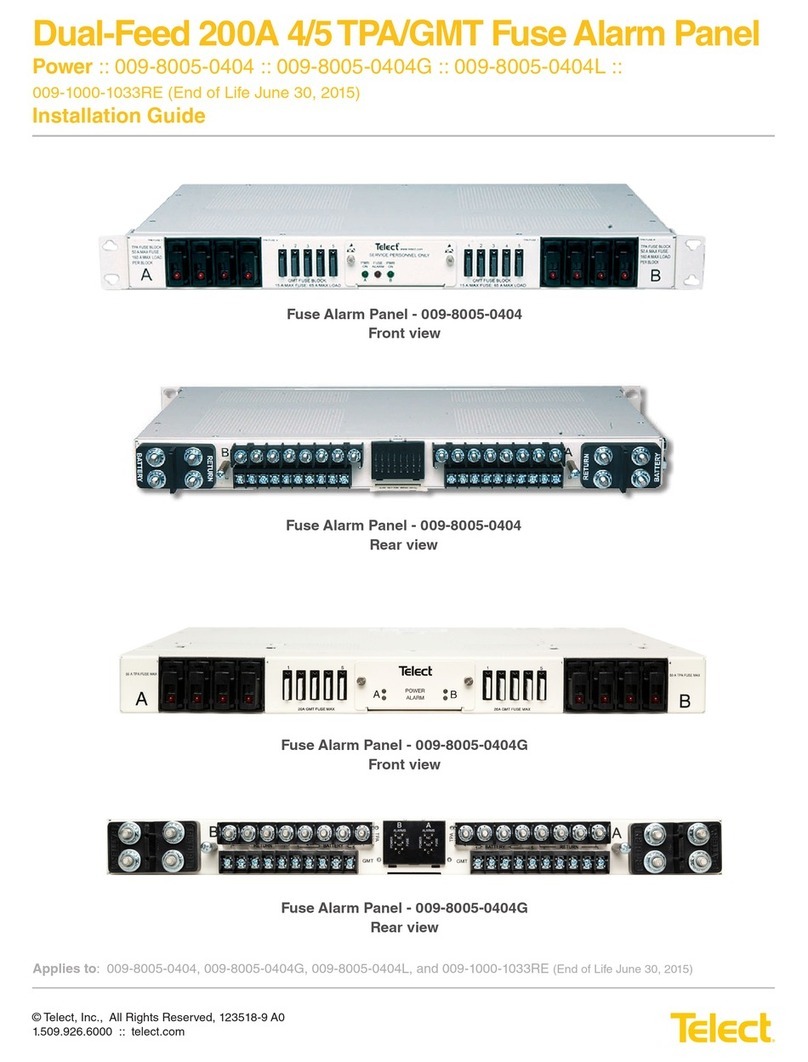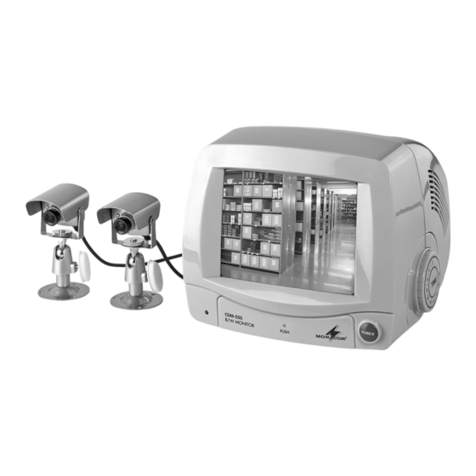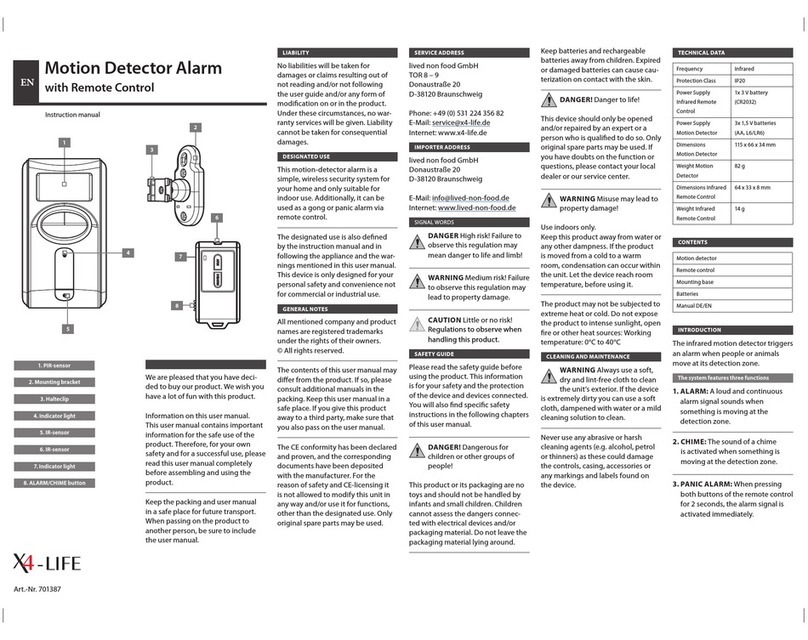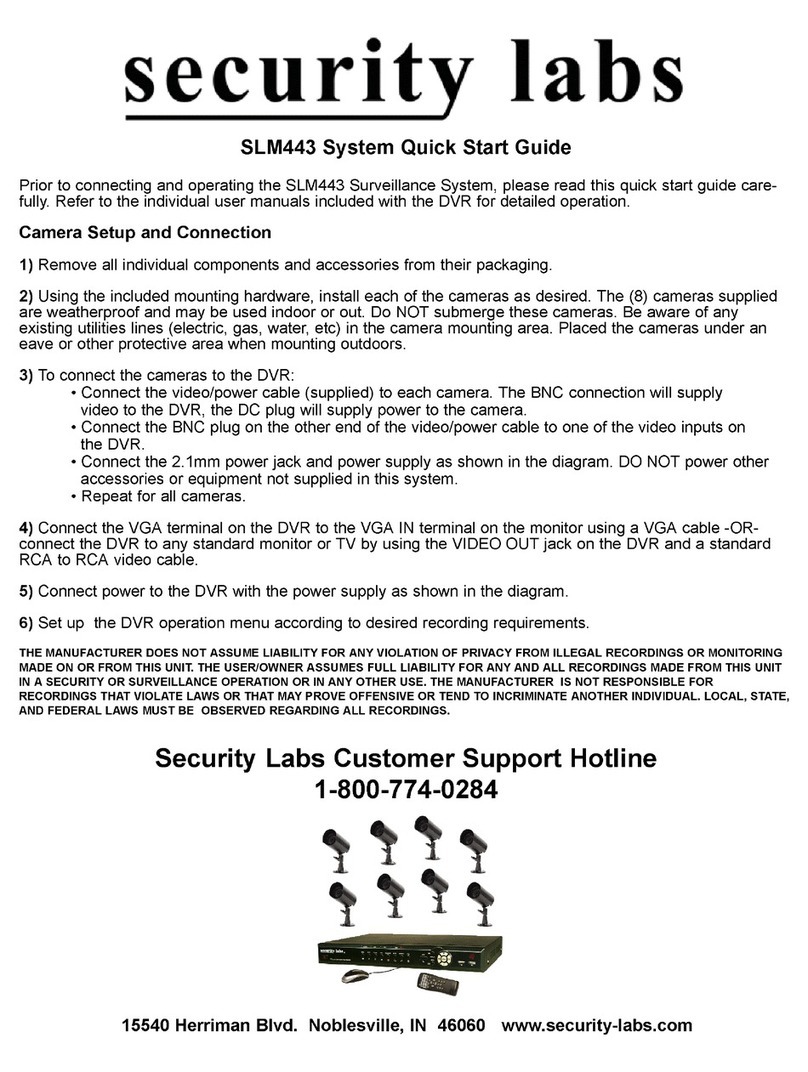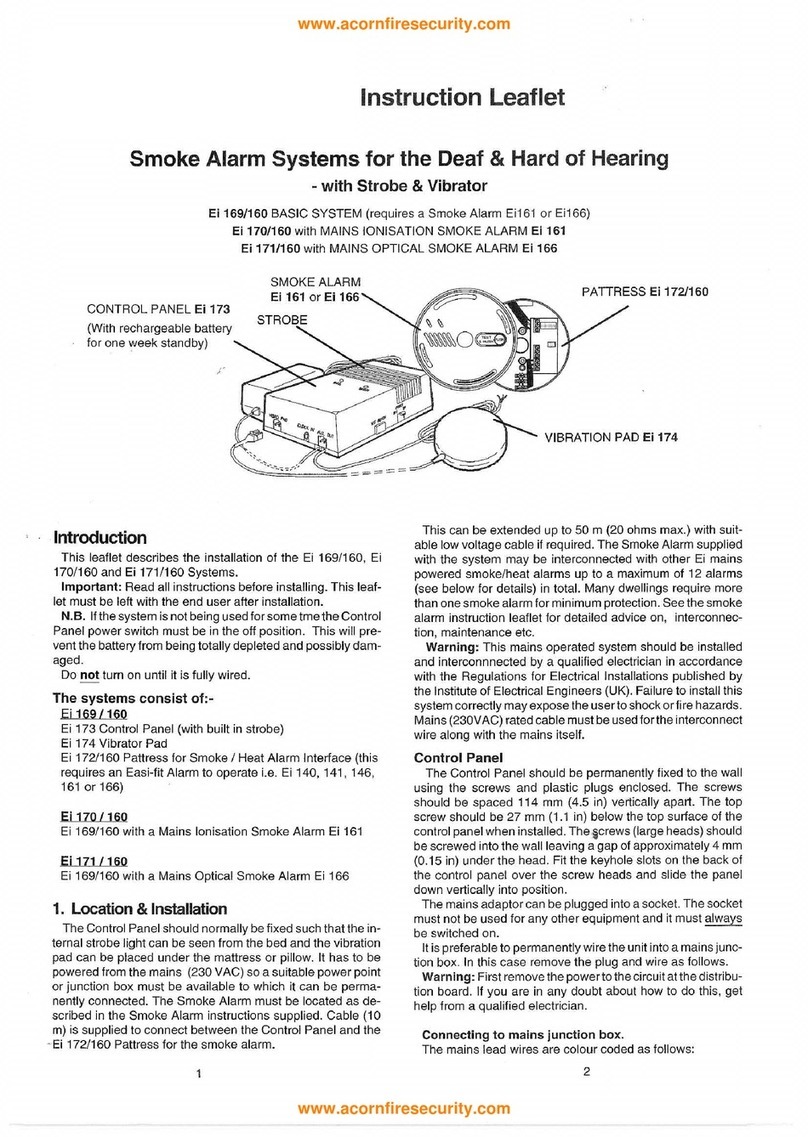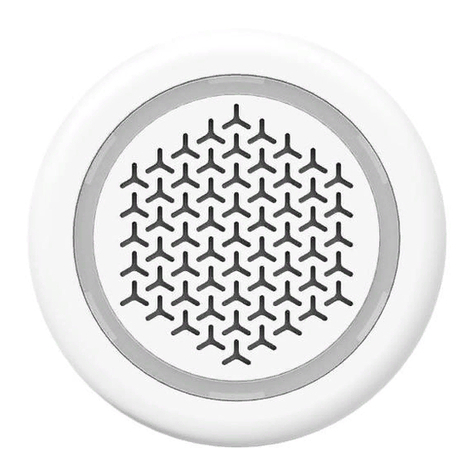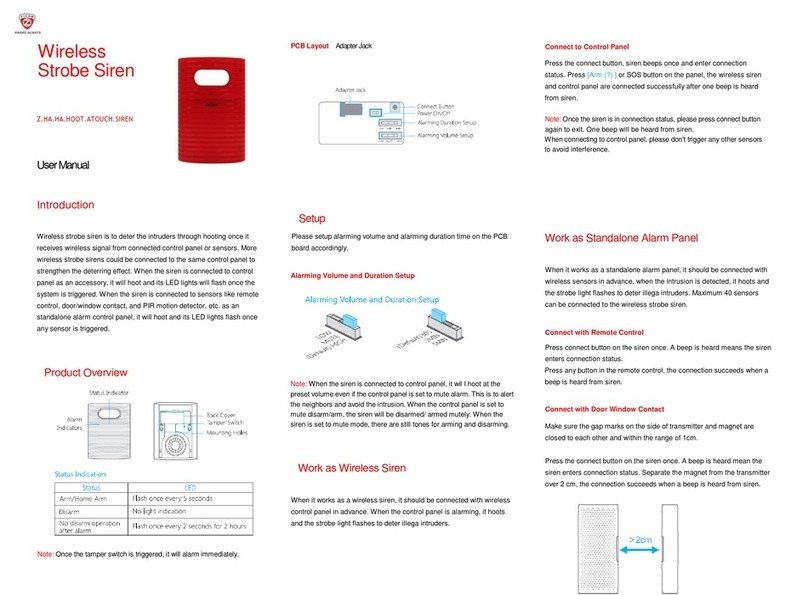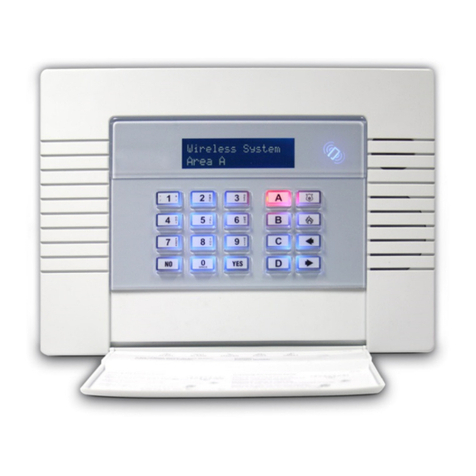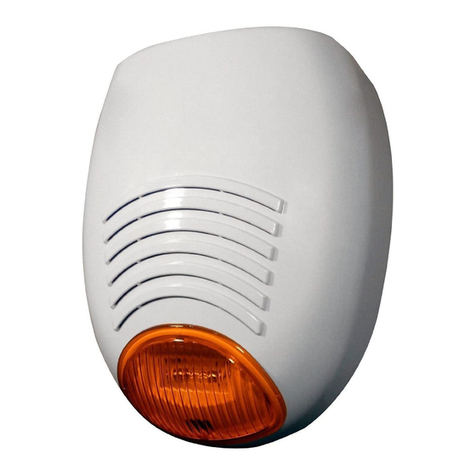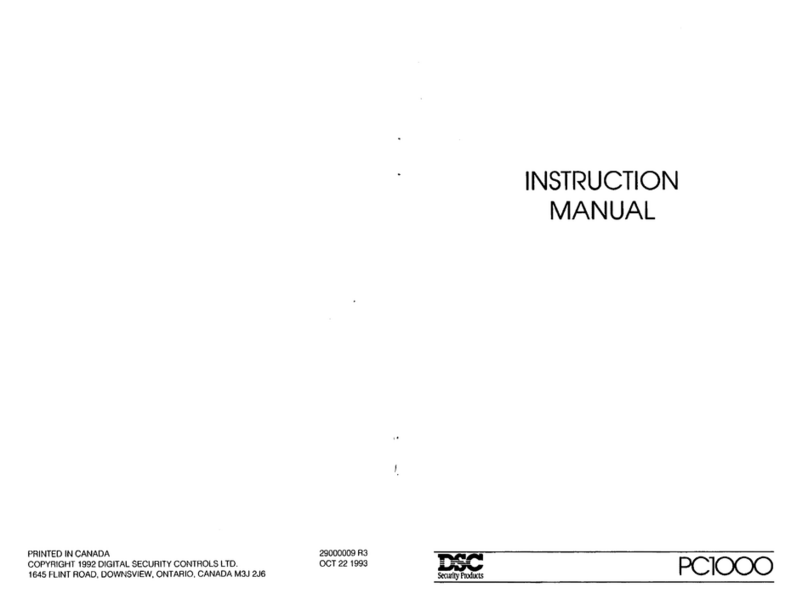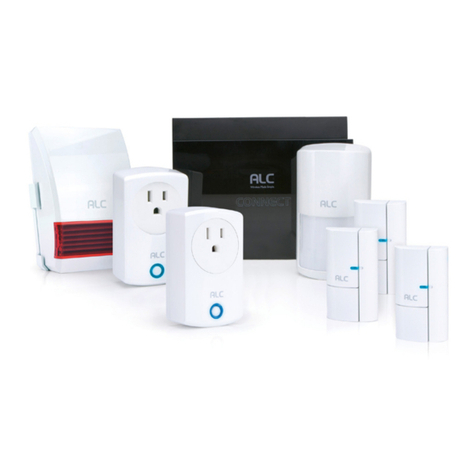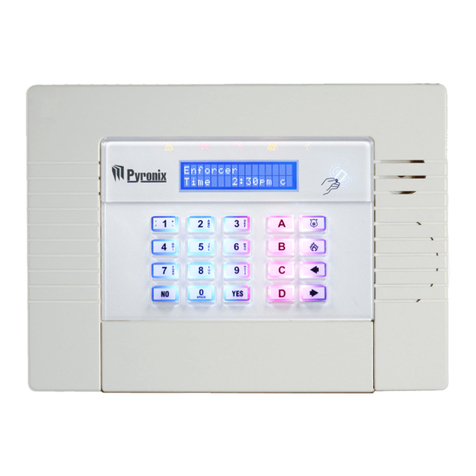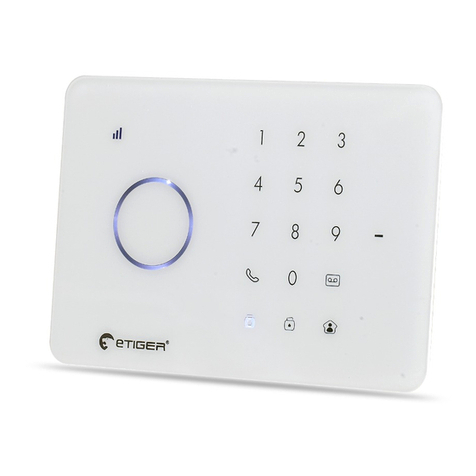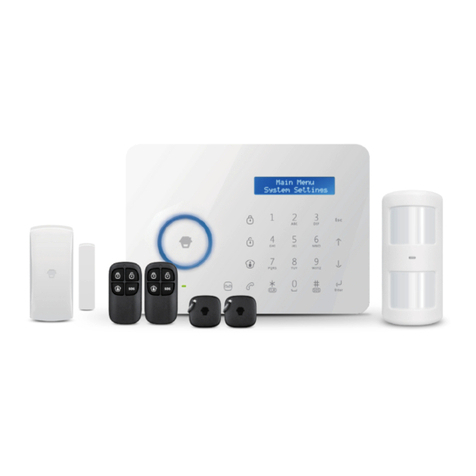Protected Home HomeSitter HS-700 User manual

HomeSitter
HS-700
Installation and Operations Manual
Protected Home
A Division of Control Products, Inc.
1724 Lake Drive West
Chanhassen, MN 55317
Document No. 42420062A

2
Table of contents
Cautions and warnings.............................. 4
Description.................................................. 5
Physical description.................................. 5
General description.................................. 6
LEDs......................................................... 6
Audible alarm ........................................... 7
What conditions activate the audible
alarm? .................................................. 7
Operation..................................................... 7
HS-700 normal operation......................... 7
How the HS-700 receives power.............. 7
Alarm operation........................................ 7
How the HS-700 handles an alarm
condition............................................... 8
DIP switch functions and settings............. 9
Initial setup.................................................. 10
Connections ............................................. 11
Connecting to AC power ...................... 10
Power up sequence.............................. 10
Battery Life, Installing Batteries............ 10
Connecting the water sensor................ 11
Connecting to a phone line................... 12
Connecting the HS-700 and another
device to the same phone jack............. 13
Phone services and your HS-700............. 14
DSL and other digital phone services... 14
Calls using a calling card or pager
phone number
..................................... 14
Creating pauses................................... 14
Call to long distance phone numbers... 14
Programming (entering phone numbers) 15
Before you start entering phone numbers 15
Entering phone numbers...................... 15
Deleting phone numbers...................... 16
Changing phone numbers.................... 16
Installation considerations........................ 16
HS-700 assembled................................... 17
Phone test ................................................ 18
Testing your HS-700 ............................ 18
Testing for a specific alarm condition... 18
Ring count timer....................................18
Calling the HS-700 during an alarm
event .................................................19
An in-phone line answering machine/voice
mail with the HS-700.............................19
How this works..................................19
Calling the HS-700 during an alarm
event .................................................19
How to cancel an alarm call out sequence
..............................................................20
Canceling an alarm call out sequence
while listening to an alarm message.20
Canceling an alarm call out sequence
by calling the HS-700........................20
Canceling an alarm call out sequence
with an answer machine/voice mail
device in the phone line with the HS-
700....................................................21
Remote status check ............................21
Troubleshooting
....................................22
Technical information
...........................23
Technical specification..........................23
FCC statement
...................................23
Plug and jack use..............................23
Ring equivalence number (REN) ......23
Telephone network interferences......24
Contact us.............................................24
Technical support..................................24
Warranty...................................................25
Warrantor: Dealer, Distributor, Retailer,
Manufacturer.........................................25
Warranty and remedy .......................25
Causes for termination of this warranty
..........................................................25
Warrantors’ liability............................25
Procedures for obtaining performance
for warranty.......................................26
To return a product to Protected Home
..........................................................26
How to request an RGA number.......26

3
Trademark
All trademarks and registered trademarks are the property of their respective owners.
The
HS-700 HomeSitter is a trademark of Protected Home. TouchTone® isaregistered
trademark of AT&T.
Copyright
© 2009 Protected Home: All rights reserved. No part of this work may be reproduced or used
in any form or by any means—graphic, electronic, or mechanical—without written
permission from Protected Home.
Purchase date, date code and serial number
For easy future reference during technical support and service, it is recommended that you
write your purchase date, date code, and serial number of the device in the spaces below. The
“date code” can be found on the label affixed to the bottom of the HS-700.
PURCHASE DATE:
DATE CODE:
SERIAL NUMBER:
Every effort has been made to ensure the information in this Installation and Operations
manual is complete, accurate, and up-to-date. Protected Home and its vendors assume no
responsibility for the result of errors in this manual, nor can it guarantee that changes in
equipment and components made by other manufacturers, in reference to this manual, will
not affect the operation or intended use of the HS-700.

4
Cautions and warnings
Cautions indicate the possibility of poor equipment performance or potential damage to the
equipment. Warnings indicate the possibility of injury to persons. The symbols shown below
identify Cautions and Warnings:
Cautions and warnings appear here and may appear throughout this manual where
appropriate. Failure to read and understand the information identified by these symbols could
result in poor equipment performance, equipment damage, or injury to persons.
Do not install the HS-700 in a confined space, such as a bookcase or in a cabinet, in direct
sunlight, or where it might get exposed to water. Failure to observe this caution could
result in poor performance or damage to the HS-700.
Any changes or modifications to this equipment not expressed in this manual could cause
poor performance or damage to the HS-700 and will void warranty.
The use of any accessory not recommended for use with the HS-700 could lead to poor
performance or damage to the HS-700.
Use ONLY the AC power adapter sent with the HS-700. Use of other AC power adapters
could result in damage to the HS-700.
Do not install the HS-700 in high dust and debris areas. Failure to observe this caution
could result in damage to the HS-700.
Do not install the HS-700 in an area with chemical fumes or corrosive vapors. Failure to
observe this caution could result in damage to the HS-700.
Do not touch the barrel connector end of the AC power adapter with wet hands when
plugged into AC power. Failure to observe this warning could result in an electrical shock.
Do not throw batteries into a fire. Failure to observe this warning could result in an
explosion.
Do not install or connect the HS-700 to power or phone line during a lightning storm.
Failure to observe this warning could result in an electrical shock.
Caution

5
Description
Physical description
Figure 1 identifies the parts of the HS-700.
Figure 1: HS-700 Parts List
Table 1: HS-700 Parts and Purpose
Part Purpose
1. Key Pad Used to enter the call-to phone numbers, activate a phone test,
and cancel an alarm.
2. LEDs (3) Power, Program, and Alarm present operational status of the
HS-700. LEDs do not function when operating on backup
battery power.
3. Battery Compartment Accommodates two AA batteries for backup power during an
AC power failure.
4. DIP Switches These switches dictate how the HS-700 will respond to alarm
conditions.
5. Water Sensor Connector Three-position terminal block used to connect the water sensor
to the HS-700 for detecting water.
6. Phone Jack RJ-11 phone jack is used to connect the HS-700 to a standard
p
hone line.
7. Power Jack Connects to the barrel connector of the AC power adapter to
provide 6 volts DC power to operate the HS-700.
8. AC Power Adapter Converts AC power to 6 volts DC power to operate the HS-
700.
9. Phone Cord Connects the HS-700 to the wall phone jack, length 7ft (2.1m).
10. Water Sensor Normally open dry contact relay closes when water is
detected, cable length 3ft (0.91m).

6
General description
The HS-700 monitors your home for a variety of alarm conditions. When an alarm event
occurs, the HS-700 calls the three entered phone numbers for the following alarms:
Temperature drops below 45ºF (7ºC) or temperature rises above 85ºF (34ºC) DIP switch
(selectable)
AC power outages for more than 15 or 60 minutes (DIP switch selectable)
HS-700 low battery condition (backup AA batteries)
Water leaks (water sensor included)
When a problem occurs at the monitored location, the HS-700 will start calling the call-list
phone numbers sequentially, over a standard phone line and describe (in English) the current
alarm(s). The HS-700 will continue calling until the alarm call out is canceled.
LEDs
The HS-700 has three LEDs: Power, Program, and Alarm located on its front panel. These
LEDs present operating status of the HS-700. Table 2 explains the operational states of the
three LEDs.
Table 2: LED Operational States
LEDs O
p
erational States
Power ON green when the HS-700 is plugged into the AC power adapter
OFF when operating in battery mode to preserve power
Program FLASHES red with a press of the PROGRAM key
ON red (not flashing) while programming phone numbers (press of
key 1, 2, or 3)
OFF in normal operation mode
OFF when AC power fails to preserve back-up battery power
Alarm ON red when in alarm mode
OFF when in normal operation mode
OFF when AC power fails to preserve back-up battery power

7
Audible alarm
The HS-700 produces a 40 db beep during an alarm event. You can turn the audible alarm
(beep) OFF for alarm conditions ONLY by setting DIP switch “6” to the DOWN position.
What conditions activate the audible alarm?
The HS-700 will beep during the following alarm events:
Temperature alarm (beeps once every 15 seconds)
Low battery alarm (beeps once every 15 seconds)
Power failure (beeps once every 10 seconds)
Water detection alarm (beeps once every 15 seconds)
Operation
HS-700 normal operation
In normal operations mode, the HS-700:
Monitors the ambient temperature thru an on-board temperature sensor.
Monitors for a power outage based on power through the AC power adapter (6 volts DC).
Monitors the AA backup batteries for low power.
Monitors the attached water sensor for the detection of water.
How the HS-700 receives power
The HS-700 receives power from a 6-volt AC power adapter, which comes with the HS-700.
Two AA batteries (not included) supply back-up power to the HS-700 during an AC power
failure.
Alarm operation
The HS-700 will monitor and send a factory-recorded voice message to the entered phone
numbers for the following alarms:
If the temperature falls below 45ºF (7ºC) or rises above 85ºF (34ºC) (DIP switch
selectable)
If power is out for either 15 or 60 minutes (DIP switch selectable)
If the unit encounters a low battery condition
If the HS-700 detects water from the water sensor

8
How the HS-700 handles an alarm condition
Sta
g
e Descri
p
tion
A. When an alarm occurs, the alarm LED lights up (if not an AC power failure),
and the HS-700 emits a beep every so many seconds depending on the alarm
type.
B. The HS-700 starts calling the call-list phone numbers in sequence, attempting
to deliver an in progress alarm voice message. If the HS-700 receives a busy
signal or no answer after 10 rings,it will immediately hang up and start
calling the next phone number in sequence.
C. The HS-700 will continue calling the call-list phone numbers, in sequence,
every 15 or 60 minutes (DIP switch selectable) until a called party answers.
D. When the called party answers (person or answering machine), the HS-700
will deliver its factory pre-recorded alarm message, identifying the specific
alarm condition(s).
E. The HS-700 will continue its calling sequence until the following action is
taken:
Locally, press the CANCEL key on the key pad.
Remotely, over the phone, press the number “1” key and then the “#” key
on the key pad anytime during the alarm message.
F. Once the alarm call-out sequence is canceled, the HS-700 will do one of two
things:
If the alarm is still active, the HS-700 allows you to call to hear the current
alarm condition.
If the alarm condition has been corrected, the HS-700 will not respond to
the incoming call.
G. When you cancel an alarm call out sequence, and correct the cause of the
alarm, the HS-700 will stop beeping, the alarm LED will go out, and the unit
will reset to normal operation automatically.
Note: During an AC power failure alarm, the Alarm and Power LEDs do not
turn ON to preserve battery power—but the unit will still beep every
so many seconds.

9
DIP switch functions and settings
The HS-700 has a 7-position DIP switch. The switch settings determine how the HS-700 will
respond to specific alarm conditions. Figure 2 shows the DIP switch and Table 3 explains the
functions of each switch. Turn the HS-700 upside down as shown in Figure 2 for proper DIP
switch orientation.
Figure 2: DIP Switches
Note: Use a ballpoint pen or similar small object to set the DIP switches.
Table 3: DIP switch settings and functions
Switch Function (switch in UP position is the default)
1 Temperature low or high:
UP, when the monitored environment temp falls below 45ºF (7.2ºC) an
alarm message is sent.
DOWN, when the monitored environment temp rises above 85ºF (29.4ºC)
an alarm message is sent.
2 Pick-up ring count when calling your HS-700 to cancel an alarm:
UP, “5” rings before the HS-700 will answer.
DOWN, “10” rings before the HS-700 will answer.
If pick-up ring count is similar to an answering machine pick up, or how
many rings you must wait before the machine responds.
3 Monitors call out frequency:
UP,call sequence happens every 15 minutes.
DOWN, call sequence happens every 60 minutes.
When the monitor goes into alarm mode, it begins calling the three call-list
phone numbers. If the alarm condition is not canceled, the calling cycle will
start again every 15 or 60 minutes until the alarm is canceled.
4 Power out alarm timer:
UP, if AC power is OFF for 60 minutes, an alarm message is sent.
DOWN, if AC power is OFF for 15 minutes, an alarm message is sent.
5 Auxiliary alarm message:
UP, if the water sensor detects water, an alarm message is sent.
DOWN, if an auxiliary event is sensed, an alarm message is sent.
An auxiliary event may be some other device that is plugged into this unit
that uses a dry contact. No other devices come included with this product.
6 Audible alarm:
UP, HS-700 will beep upon detecting an alarm condition.
DOWN, HS-700 will NOT beep upon detecting an alarm condition.
The alarm will beep during certain key pressing during set up or when
entering test mode regardless of the switch position setting.
7 Not used.

10
Initial setup
Connecting to AC power
Do not touch the barrel connector end of the AC power adapter with wet hands when
plugged into AC power. Failure to observe this warning could result in an electrical shock.
Do not install or connect the HS-700 to power or phone lines during a lightning storm.
Failure to observe this warning could result in an electrical shock.
Power up sequence
Upon power up, the HS-700 LEDs will do the following:
The Power, Program, and Alarm LEDs will light for a few seconds, then the Program and
Alarm LEDs will turn OFF
The Power LED will remain ON
Note: A surge protector is recommended, but not provided. You can purchase a surge
protector from Protected Home or from a local computer or hardware store.
To connect AC power to the HS-700 through the AC power adapter, follow the number
sequence shown in Figure 3.
Figure 3: Connecting the AC Power Adapter

11
Batteries
Battery handling and safety
Do not throw batteries into a fire. Failure to observe this warning could result in an
explosion.
Note: REMOVE the batteries when the HS-700 is not in service.
Battery life
If the back-up battery voltage drops below 2.35 volts, a low battery alarm will be sent, even
when the unit is powered by the AC power adapter. The HS-700 will call the call list phone
numbers and issue a low battery alarm message. If the unit is operating on battery power only
(after an AC power failure), the calling sequence will continue until battery power drops to
approximately 1.9 volts. Typically, most good alkaline batteries should provide
approximately 12 hours of continuous power.
Note: If the low battery alarm was due to an extended AC power failure, it is recommended
that you replace the batteries. Also, a false low battery alarm can occur if the AA
batteries have not been installed and AC power is connected to the HS-700.
You CANNOT enter phone numbers when the HS-700 is running only on battery power.
Note: The HS-700 uses two AA batteries for backup power.
Installing the batteries
Note: To avoid a false low battery alarm, please connect the AC power adapter to the HS-700
and the wall outlet before inserting batteries.
To install the batteries, follow the Steps shown in Figure 4.
Figure 4: Battery Installation Connections

12
Connecting the water sensor
To connect the water sensor to the HS-700, do the following:
Note: You can lengthen the cable of the water sensor to 100ft (30.8m), using the equivalent
size wire. (24 gauge, 2 conductor wire)
Figure 3: Water Sensor Connected to HS-700
Connecting to the standard phone line
To connect the HS-700 to a phone line, do the following:
Figure 4: HS-700 Connected to Phone Line
1
Water Sensor
Plug water sensor
connector here
HomeSitter

13
Connecting the HS-700 and another device to the same phone jack
If you need to connect the HS-700 and some other device, such as a telephone, to the same
wall phone jack, simply use a phone jack splitter (not provided). To use a splitter, do the
following:
Ste
p
Action
1. Plug the line splitter into the wall jack as shown in Figure 7.
2. Plug one phone card into one jack on the line splitter, as shown in Figure 7.
3. Plug the second phone card into the other jack on the line splitter.
4. Plug the other end of the one phone cord into the HS-700.
5. Plug the other end of the remaining phone cord into the phone or other device.
Figure 5: Phone Line Splitter
Note: Both units will operate from the same jack independently without cross interference.
Line Splitters can be purchased at most hardware and electronic stores.

14
Phone services and your HS-700
DSL and other digital phone services
Please note that the HS-700 is designed and certified by the FCC to operate on a standard
telephone line, provided by your local telephone company. DSL, Cable, or Digital phone
service may work with the appropriate in-line filters. If you have questions or problems
using one of those types of phone services, contact that specific phone service provider
for assistance.
Note:
The
HS-700 dials out using touch tone dialing only.
During power failures, many alternative phone services such as DSL, Digitaland Cable
provided phone service DO NOT WORK.Those phone services require that power be on at
the location for the phone to operate. The HS-700 will NOT be able to call out if the
power is out when using these phone services. If you have a standard telephone line, power
is supplied to this line by the telephone company and is usually not affected when power
goes out at the monitored location.
Calls using a calling card or pager phone number
When using a calling card or pager system, you often need to include pauses to ensure that
enough time is allotted to dial the phone number. To get a sense for how much time that may
be needed, call the preferred calling card or pager to gain an understanding of how that
system works. Often times, the calling card or pager system, may announce “enter your
calling card number followed by the pound (#) key.” Make sure to include all necessary key
presses as you enter the number. Also, while the card or pager system is talking (number of
seconds), you will need to enter pauses for that time to allow the system adequate time to
accept your telephone number.
Creating pauses
You can add pauses to your telephone number as you enter it into the HS-700 by pressing the
STAR (*) key two times, which represents a 2-second pause. If you need to enter a 6-second
pause, press the STAR (*) key six times.
Note: Always press the STAR (*) key twice (in multiples of 2) to create an effective pause;
otherwise, a single press of the STAR key will be literally translated as part of the
dialed phone number.
Calls to long distance phone numbers
Long distance calling: make sure you enter the phone number exactly as you would when
dialing a long distance call yourself (“1” and area code if needed). If dialing internationally,
make sure you have the correct country codes and follow proper international dialing rules.
Check with your phone company for assistance to determine the correct number.

15
Programming (entering phone numbers)
You can program the HS-700 with up to three phone numbers (60 digits each), which it uses
to communicate alarm messages.
Before you start entering phone numbers
DO NOT enter phone numbers of emergency services (fire, police or ambulance) into the
HS-700.
DO NOT forget the area code and then enter the phone number exactly as you would when
making a personal phone call.
Long distance dialing: enter “1,” the area code if required, and then the phone number.
It is critical that you run a system test to validate the call-to numbers. For proper testing, it is
recommended that a person at the call-to location confirms receiving the call.
Note: You cannot enter phone numbers when the HS-700 is running only on battery power.
Entering phone numbers
Note: Phone numbers are stored in non-volatile memory (permanently stored in the HS-700
regardless of power failures or long-term storage).
To enter phone numbers into the HS-700, do the following:
Ste
p
Action
1. Make sure the HS-700 is in normal operation mode.
2. Press the PROGRAM key—a beep and the program LED starts flashing.
3. Press the number “1” key to select the first location—a beep and the
program LED is ON, not flashing.
4. Enter the phone number (up to 60 digits)—beeps with each key press.
5. Press the PROGRAM key—a beep and the program LED will start flashing.
The number was entered successfully and the unit is still in program mode.
6. Press the number “2” followed by a phone number to add the second phone
number.
7. Press the PROGRAM key—a beep and the program LED will start flashing.
The number was entered successfully and the unit is still in program mode.
8. Press the number “3” followed by a phone number to add the third phone
number.
9. Press the PROGRAM key-this will save the final programmed number
10. Press the PROGRAM key again to exit program mode—a beep and the
program LED goes out. (if programming less than 3 phone numbers, enter
the Program Key to exit programming mode when complete. The program
L
ED will
g
o out
)

16
Deleting phone numbers
To delete a phone number, do the following:
Step Action
1. Press the PROGRAM key—a beep and the program LED starts flashing.
2. Press the number 1, 2, or 3 key of the location of the phone number that you
want to delete—a beep and the program LED is ON, not flashing.
3. Press the PROGRAM key to delete the phone number—a beep and the
programming LED starts flashing. The number was deleted successfully.
4. Press the PROGRAM key to exit program mode when done—a beep and the
program LED goes out.
Changing phone numbers
Follow the “entering phone number” procedure to overwrite any or all three phone numbers.
Installation considerations
The HS-700 should be installed in a dry, clean location near an AC power outlet and a
telephone wall jack, as shown in Figure 8.
Do not install or connect your HS-700 monitor to power or phone lines during a lightning
storm. Failure to observe this warning could result in an electrical shock.
Do not install the HS-700 in a confined space, such as a bookcase or in-cabinet, in direct
sunlight, or where it might get exposed to water. Failure to observe this caution could
result in poor performance or damage to the HS-700.
Use ONLY the AC power adapter sent with the HS-700. The use of other AC power
adapters could result in damage to the HS-700.
Do not install the HS-700 in high dust and debris areas. Failure to observe this caution
could result in damage to the HS-700.
Do not install the HS-700 in an area with chemical fumes or corrosive vapors. Failure to
observe this caution could result in damage to the HS-700.
Caution

17
HS-700 assembled
Figure 8 shows an example of an ideal setup of the HS-700 fully assembled. Place the HS-
700 on any flat surface, preferably a table top near an AC Power outlet and a phone jack as
shown in Figure 8. Once the HS-700 is fully assembled and operational (power LED ON),
perform a phone test to ensure that the HS-700 can call the call-list phone numbers during an
alarm.
Figure 6: HS-700 Assembled
CANCEL
TEST
PROG
0
9
8
6
5
4
123
7
ProgramAlarm
Power
Power ON LED

18
Phone test
After entering all phone numbers, it is crucial that you test your HS-700 to verify that it can
reach the call list phone numbers.
Note: The CANCEL key does not function when the HS-700 is in “test mode.”
Testing your HS-700
To test the HS-700, do the following:
Step Action
1. Make sure the HS-700 is powered up and in normal operation mode.
2. Press the TEST button—the HS-700 beeps and the alarm LED starts
flashing.
3. Press the number 1, 2, or 3 key of the phone number that you want to
contact—a beep and the alarm LED is ON, not flashing. The following will
occur:
HS-700 will immediately dial the desired phone number stored at key pad
location 1, 2, or 3.
Upon answering, the unit will play the following message: “This is a test
of the HomeSitter Alarm.”
It will repeat this message for approximately “1” minute and then hang
up, and the alarm LED will go out.
4. Repeat Steps 2 and 3 to test the remaining phone numbers.
The HS-700 does not provide any indication of call success; therefore, you must verify that
the call was made successfully.
Testing for a specific alarm condition
To test for a specific alarm condition (temperature, water, power) you will have to simulate
that specific alarm condition and then verify if the alarm phone calls went through. In those
scenarios, you must cancel the alarm call out sequence and correct the alarm condition.
Ring count timer
The ring timer works in the following way: when the first call comes in during an alarm
event, the timer starts counting down for “3” continuous minutes. If the HS-700 receives
enough rings to answer (within “3” minutes), it will respond, and the ring counter will reset
to “0” regardless if the three minutes have elapsed or not. Also, the timer will reset to “0” if
no additional calls are received during a three minute period (multiple calls to the HS-700
within “3”minutes will not reset the ring timer).

19
Calling the HS-700 during an alarm event
To call the HS-700 during an alarm, do the following:
Step Action
1. Call the phone number of location where the HS-700 is located—the HS-700
will answer in 5 or 10 rings (DIP switch set) and deliver an alarm specific
message.
2. Listen to the message describing the alarm condition.
3. Hang up the phone.
An in-phone line answering machine/voice mail with the
HS-700
When it is necessary to connect an answering machine or voice mail device to the same
phone line as the HS-700, you can still use all the features of these devices, along with being
able to check status and cancel an alarm call out of the HS-700.
How this works
During setup, you can manually set the HS-700 to answer on a specified number of
incoming rings “5” or “10” (DIP switch 2, ring count).
Set your answering machine or voice mail to answer in fewer rings than the HS-700. (For
example, if the HS-700 is set to answer on 5 rings, set the other device to answer in “4” or
fewer rings.) Therefore, when a call comes into the location of the HS-700, the answering
machine/voice mail will respond first because it is set to answer in fewer rings than the
HS-700.
Calling the HS-700 during an alarm event
The following example shows how to call the HS-700 during an alarm event:
Criteria
HS-700 ring count is set to “5” rings to answer (factory default DIP switch setting).
Answering machine/voice mail is set to “4” rings to answer.
You must make the appropriate number of phone calls to the location where the HS-700 is
within “3” minutes or the timer in the HS-700 will reset to “0.”
To get the HS-700 to respond given the above example criteria, do the following:
Step Action
1. Call the phone number of the location where the HS-700 is located, and let the
phone ring “3” times and then hang up. The internal 3-minute timer starts and
the HS-700 tallies and remembers the number of rings.
2. On your second call within “3” minutes, let the phone ring until the HS-700
answers. The HS-700 will answer first because it remembered the first “3”
rings, and then it added the rings from the second call until the total reached “5,”
then it answered before the answering machine/voice mail device (“4” rings to
answer
)
.
3. Listen to the alarm message.
Note: If the HS-700 is set to answer in 10 rings (the second choice on DIP SW2), you may
need to place more calls within “3” minutes to get the HS-700 to eventually answer.

20
How to cancel an alarm call out sequence
You can cancel an alarm call out sequence in two ways:
Remotely, press the number “1” key and then the pound (#) key at any time during the
alarm message.
Locally, press the CANCEL key on the key pad.
Canceling an alarm call out sequence while listening to an
alarm message
To cancel a call out sequence while listening to an alarm message, do the following:
Step Action
1. Pick up the phone.
2. Listen to the alarm message.
3. When told, press the number “1” key.
4. Press the pound (#) key within “1” minute to cancel the alarm call out.
5. You can listen until you hear the HS-700 say goodbye or just hang up the
phone.
Note: Canceling the call out sequence does not cancel an active alarm (the HS-700 will
continue to beep and the alarm LED will be lit).
Canceling an alarm call out sequence by calling the HS-700
To cancel a call out sequence during an active alarm, do the following:
Step Action
1. Make the call to the HS-700 (phone number at alarm location)
2. Wait for the HS-700 to answer (5 or 10 rings—DIP switch selectable)
3. Listen to the alarm message.
4. Press the number “1” key.
5. Press the pound (#) key anytime during the message to cancel the alarm call out.
6. Hang up the phone.
Table of contents
Other Protected Home Security System manuals

